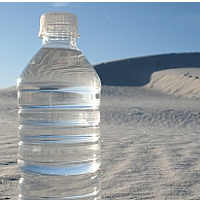Drought-Plagued California Bottles Its Water for the Rest of the Country

Companies have been bottling water in this country for a century but didn’t begin to heavily market the public natural resource back to the public until around 1976, when Perrier was on the lips of everyone who could afford it.
The Arrowhead Springs Company began taking water from the ground in San Bernardino County in 1909 and other water bottlers have found the state a good place to set up shop for a long time, although limited water resources have always been a contentious issue in California.
But now the state is suffering a historic drought and shipping California water to other parts of the country and the world looks a tad unseemly. Julia Lurie at Mother Jones says if you’re drinking bottled water “there’s a good chance” it came from California.
Aquafina, Dasani, Crystal Geyser and Arrowhead all have operations in California, she wrote, although Lurie doesn’t quantify how much of the nation’s bottled water comes from the state. The reason is an absence of data. Bottling companies don’t have to say where the water comes from, and, for the most part, they don’t on their labels.
A story by Kate Sheppard in the magazine last year pointed out that just 55% of bottled water comes from springs. The rest is treated tap water. The Environmental Working Group (EWG) tried to find out more in 2011 and was stonewalled by the industry (pdf). Around 18% of the 173 bottled-water brands surveyed did not give any information about where their product came from.
A lot of the information they did get was vague. For instance, Arrowhead, which is produced by Nestle, only listed potential sites in California, but no specific locations. Thirty-two percent of those who responded didn’t provide information about water purity or treatment procedures on their labels.
Crystal Geyser’s own website shows two of its seven locations are in California; one at Mount Shasta and the other below the slopes of Olancha Peak near Mount Whitney.
California has required companies selling bottled water in the state since 2009 to include the source on the label. But it’s not a practice followed nationwide. The California requirement was part of a larger law passed in 2007 and, at the time of EWG’s survey, was widely ignored. Only 34% of the 96 brands looked at listed a specific source and the required two ways for consumers to contact the company.
The drought has cast a spotlight on Nestle operations at the foot of the San Bernardino Mountains, which have been a source of conflict for a decade. Nestle struck a deal with the Morongo Band of Mission Indians to draw water from a spring on the tribe’s reservation. Skimpy pumping information in an area suffering from declining groundwater resources has been further obscured by the tribe’s standing as a sovereign entity.
Even when Native American sovereignty isn’t an issue, information about groundwater pumping is deficient. Groundwater accounts for 30-40% of the state’s total water supply, but California is the only Western state that doesn’t manage the resource. Because California property owners essentially have the right to all the water beneath them, the state hasn’t bothered setting up a system to monitor where, and how many, wells are drilled and how much water is pumped out.
California water appropriated for bottling is admittedly a very small portion of water used in the state. Despite daily warnings from officials that consumers must dramatically reduce their water usage or pay big penalties, between 80% and 90% of the dwindling resource is actually sucked up by agriculture. Around 3% is consumed by industry and 4% by households.
A lot of the agricultural product is shipped out of state. The Pacific Institute calculated (pdf) that half the state’s water usage went to producing goods and services for export, and “this virtual water export is likely a reflection of the role California’s agricultural industry plays in supplying a significant portion of the nation’s fruits and vegetables.”
They can wash it down with California water.
–Ken Broder
To Learn More:
Bottled Water Comes from the Most Drought-Ridden Places in the Country (by Julia Lurie, Mother Jones)
Does Poland Spring Water Actually Come from Poland Spring? (by Kate Sheppard, Mother Jones)
2011 Bottled Water Scorecard (by Nneka Leiba, Sean Gray and Jane Houlihan, Environmental Working Group) (pdf)
Nestle Partners with Tribe for Under-the-Radar Groundwater Pumping in the Desert (by Ken Broder, AllGov California)
- Top Stories
- Controversies
- Where is the Money Going?
- California and the Nation
- Appointments and Resignations
- Unusual News
- Latest News
- California Forbids U.S. Immigration Agents from Pretending to be Police
- California Lawmakers Urged to Strip “Self-Dealing” Tax Board of Its Duties
- Big Oil’s Grip on California
- Santa Cruz Police See Homeland Security Betrayal in Use of Gang Roundup as Cover for Immigration Raid
- Oil Companies Face Deadline to Stop Polluting California Groundwater





